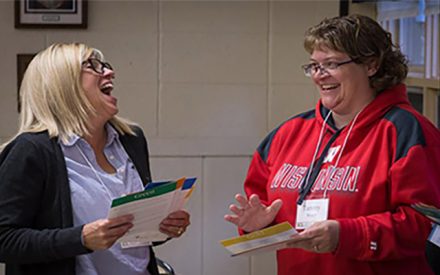I recall many evenings spent laughing, tears rolling down my cheeks, when the improvisational comedy show “Whose Line is it, Anyway” first aired on ABC. I was completely enthralled with the idea of creating these bizarre, but relatable situations in the moment from just one word or phrase.
Then I realized that we all do this already, every single day. Maybe the situations aren’t as bizarre, though there’s a reason for the phrase “I couldn’t make that up if I tried.” But every minute of every day, we are unscripted. We are all improvisers. We take in our environment, listen to what’s going on around us, what people are saying to us, and we react.
Despite this, many of us know we could do better with listening, communication, warding off perfectionism, and other things that affect our work performance and satisfaction with personal relationships. We can learn a lot from those who study improv. Improvisers are masters at adapting, supporting each other, being present in the moment, listening, co-creating, and more.
As a leader, you can look to improv as a tool for developing your team. Finding ways to use improv to engage your group(s) could be just the thing you were looking for.
Improv: from the stage to the field
Improv is fairly well known across North America as a theater art form with no script. Applied improvisation, however, is a relatively new field that takes the lessons and skills of improv and applies them to real life. Leaders across disciplines, including scientists, medical professionals, therapists and trainers use applied improvisation in a variety of settings. For example, improv has been used to help professionals in scientific and medical roles learn how to communicate with people outside of science and medicine.
Facilitators that study applied improvisation use their skills to assist with:
- Systems change
- Team building
- Goal setting and visioning
- Sparking creativity and innovation
- Leadership development
- Building communication skills
- Conflict resolution
- Emotional intelligence/empathy building
Some of our Wisconsin, community-based leadership programs have begun incorporating improv games into their sessions. Extension has introduced improv to the Soil Sisters and Women in Wisconsin Public Television, as well as community groups.
“I can’t thank you enough for training us in such a fun and engaging way. I got so many compliments from the staff, some even saying that the training was the most fun they have been to. Congratulations and thank you! I loved how you tied in the leadership lessons to the lessons of improv.”
– Organizer, Women in Wisconsin Public Television
Replacing warm-ups and icebreakers with improv games
One of the first things that draws facilitators, meeting planners, and managers to the use of improv with groups is the desire to maximize participation.
If you have used warm ups and icebreakers with your team then you have heard the groans about participating. Many people see little value in the activities. Treating any agenda item as though it is just an icebreaker does a disservice to your group. No on wants filler items on an agenda.
Improv games, when chosen wisely, can replace warm-ups and icebreakers with engagement that simultaneously builds your team’s ability to be open, responsive and mindfully present. No matter what your team’s goals are, there is likely an improv game that can help.
Matching improv games to your group goals
When planning your improv games, it is important to consider what kind of engagement you hope to achieve with your group. Likewise, games should be chosen with the group culture and personality in mind. Your goal for each game should be to create safe spaces while pushing your group to try new things together.
Ask yourself these questions to help you choose the right improv activity:
- What do I hope to achieve with this group? What need am I attempting to address?
- Who will be participating? What are they like? What are the group’s needs from me as a facilitator? What does the group need from each other? How long has this group known each other?
- What is the organizational culture like? Will different power dynamics be in the room? How can we create a safe space to build trust, strengthen relationships, foster creativity and innovation, develop a growth mindset, and sharpen adaptive leadership skills?
- Which kind of improv games will be most useful in meeting the need and purpose of the group
“‘The Leadership Lessons From Improv’ workshop has proven to be effective in building the essential leadership skill of dialogue across differences. Improv has shown to be a great, engaging way to help in building teams and strengthen connections. Our participants have also shared that experiencing improv has helped in uniquely understanding and promoting creativity, adaptability, and effective communication. It is consistently one of the favorite sessions in leadership development education.”
– Victoria Solomon, Green County Leaders
Give applied improvisation a try
The best way to learn more about improv is to try it out. Give one of my favorites a shot the next time you work with a group. As a bonus, they can both be played online.
Sound Ball
- Purpose: Building trust, inspiring creativity, developing a growth mindset, nonverbal communication skills
- Instructions:
- Form a circle.
- Explain that you have a very smart, invisible ball in your hand. Mime tossing it to a participant and have them catch it and throw it back to you.
- Further explain that the ball makes a new sound every time it’s tossed, and repeats the sound as it is caught. This time, make a sound as you toss the ball to a participant and coach them to repeat the sound.
- Tell them to keep the ball this time and toss it to another participant while making a new sound. This sound will be echoed by the receiver and so on.
- After a few tosses, encourage everyone to go faster.
- (optional) Continue the game, adding more balls (multiple sounds at the same time). Encourage everyone to go faster.
- Debrief (optional):
- How did this feel?
- Did anyone worry about creating a “good” sound? Did anyone plan their sound ahead of time? Why?
- Did anyone feel like someone else made a better sound than they did?
- What are some of the reasons we compare our sounds to others or judge our sounds as “bad?”
- How does this relate to building trust? How does this relate to communication?
- Did your experience of the game change when you were asked to go faster or multiple balls were added? How?
- What does this tell us about our tendencies to censor ourselves in real life?
- The ball is fake, and no specific sounds are required, so failure with this activity is impossible. So why would we evaluate our performance during this activity?
- Online adaptation
- As each person tosses the ball, they say the name of another participant just before the ball is tossed.
- Refrain from using multiple balls; it will be difficult to hear the names and sounds.
- All other instructions and debrief apply.
One Word At a Time Story
- Purpose: Inspiring creativity, building adaptivity skills, developing a growth mindset, accepting team member contributions (team building), listening (communication skills)
- Instructions:
- Gather everyone in a circle.
- Provide a topic or title for a story. Some options might be:
- Tell the story of this group/program/organization.
- Choose a favorite childhood story or fairy tale (and remind everyone that they don’t have to know anything about the story in order to participate).
- Choose a famous fictional character to tell a story about (ie: Father Time, Mother Nature)
- Encourage them to go as fast as they can, while still forming complete sentences.
- Tips:
- Remind them that, if it feels like they’ve come to the end of a sentence, the next participant in the circle can end it using the inflection of their voice. OR, they may say “period,” and the same participant that ended the sentence may then choose the next word to begin a new sentence.
- Groups often slow down as they think, keep encouraging them to go faster if the story is slowing.
- Encourage them to listen to each other.
- Debrief (optional):
- How did this feel?
- Did anyone censor themselves? How?
- Did anyone compare their words/compare their contribution to the story with the contributions of others? Why?
- Words like “a, the, and” are just as important to a story as larger words. How does this relate to team contributions?
- Why did I encourage you to go quickly?
- How does this relate to communication in our daily lives/on our teams?
- Online adaptation
- This can be done online in two ways through breakout rooms of 2-5.
- Choose the number of people that will be in each breakout group.
- Instruct them to decide on an order once they get to their room, and begin as soon as they have established the order.
- All other instructions and debrief are the same.
- Optional – give it a try with larger groups by assigning a number to each person and asking them to change their display name to that number. Starting with number one, start telling your story. Pay attention to when the last person goes and quickly announce the next round (“back to the beginning!” or similar).
- This can be done online in two ways through breakout rooms of 2-5.
Koppett, Kat. Training to Imagine: Practical Improvisational Theatre Techniques for Trainers and Managers to Enhance Creativity, Teamwork, Leadership and Learning. Stylus Pub., 2013.
Madson, P. R. (2005). Improv Wisdom: Don’t Prepare, Just Show Up (1st ed.). Bell Tower.
Connect with us!
- If you want to learn more about how you can use applied improvisation with your team, contact Jessica Beckendorf.
- Improve your skills as a leader by checking out our community-based leadership programs.


 How and why we must improve civic health
How and why we must improve civic health Transform your team by understanding your Real Colors®
Transform your team by understanding your Real Colors® Culturally Responsive Strategic Planning
Culturally Responsive Strategic Planning What you can learn about your community from demographics
What you can learn about your community from demographics


